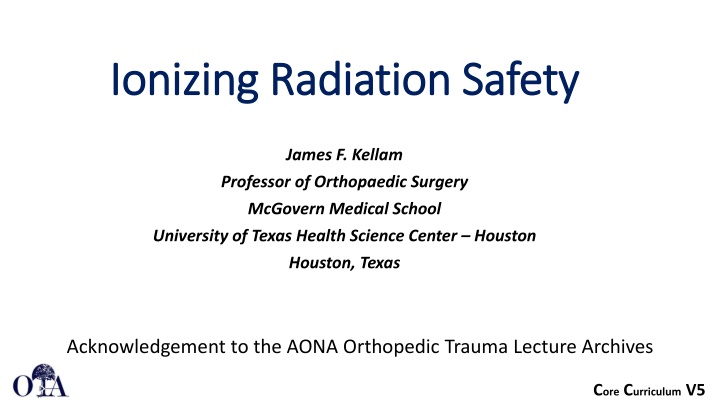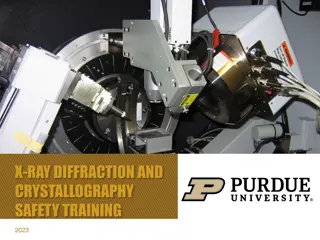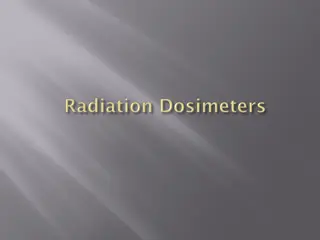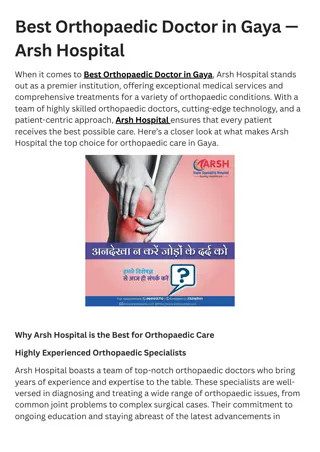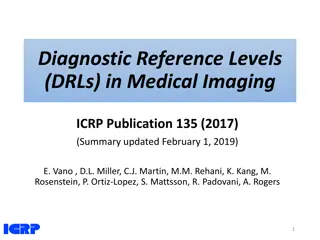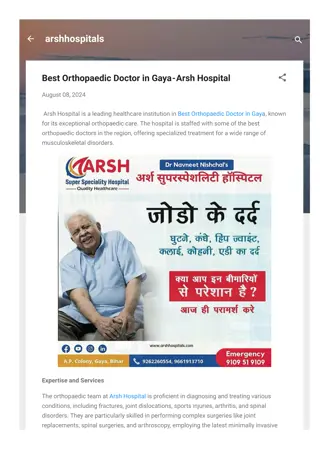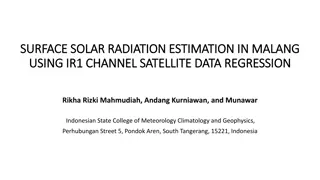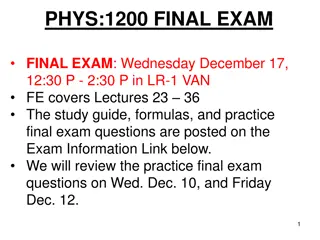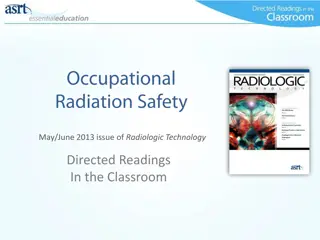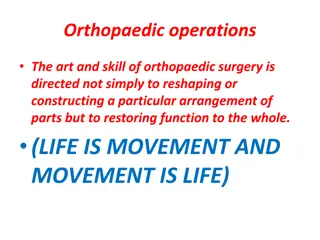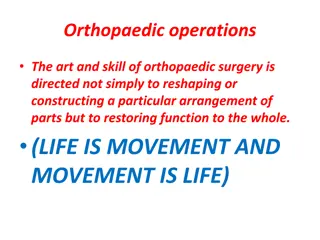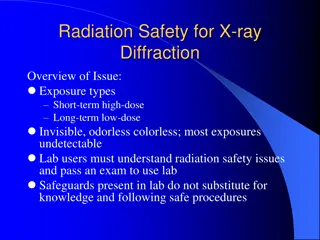Ionizing Radiation Safety in Orthopaedic Surgery
This content covers the importance of ionizing radiation safety in orthopaedic surgery, including physical facts, modern orthopaedics' use of radiation, and precautions to protect patients and healthcare teams. It discusses x-ray production, radiation effects, and the need for justified radiological investigations.
Download Presentation

Please find below an Image/Link to download the presentation.
The content on the website is provided AS IS for your information and personal use only. It may not be sold, licensed, or shared on other websites without obtaining consent from the author.If you encounter any issues during the download, it is possible that the publisher has removed the file from their server.
You are allowed to download the files provided on this website for personal or commercial use, subject to the condition that they are used lawfully. All files are the property of their respective owners.
The content on the website is provided AS IS for your information and personal use only. It may not be sold, licensed, or shared on other websites without obtaining consent from the author.
E N D
Presentation Transcript
Ionizing Radiation Safety Ionizing Radiation Safety James F. Kellam Professor of Orthopaedic Surgery McGovern Medical School University of Texas Health Science Center Houston Houston, Texas Acknowledgement to the AONA Orthopedic Trauma Lecture Archives Core Curriculum V5
Learning outcomes Why is this important Describe the physical and biological facts of radiation Demonstrate an understanding of how to use x-rays during orthopaedic procedures and decrease exposure Understand how to protect patients, teams and surgeons from radiation during surgery Acknowledgement to the AONA Orthopedic Trauma Lecture Archives Core Curriculum V5
Modern Orthopaedics and Ionizing Radiation Increased use of radiation Diagnostic accuracy Minimally invasive procedures Intramedullary (IM) nailing Surgical efficiency Always need to justify why you need this radiological investigation Core Curriculum V5 Acknowledgement to the AONA Orthopedic Trauma Lecture Archives
Why? Why? As a surgeon you are responsible for ordering this test Radiation is dangerous and effects cumulative Must be used only as needed Limit the potential problems to your patients and you Other imaging uses sound waves(ultrasound), magnetic waves(MRI) and not tissue damaging Acknowledgement to the AONA Orthopedic Trauma Lecture Archives Core Curriculum V5
Physical facts Radiation is energy from electromagnetic waves Ionizing radiation penetrates biological tissue Frequency: 2.5x1017 6x1019 Hz Core Curriculum V5 Acknowledgement to the AONA Orthopedic Trauma Lecture Archives
Physical Facts: X-ray production Heated filament(cathode) produces electrons (tube current in milliamperes ma) Electrons accelerated by accelerating voltage kVp to an anode (tungsten) Electrons interact with anode to produce x-rays kVp produces more x-rays than ma kVp ma Acknowledgement to the AONA Orthopedic Trauma Lecture Archives
Physical Facts: Tissue Penetration Acknowledgement to the AONA Orthopedic Trauma Lecture Archives
Radiation Exposure: Measurement - Generic Roentgen = Quantity of x-rays required to produce an amount of ionization in air at standard temperature and pressure 2.58X10-4 Coulombs/kilogram (C/kg) for air only Gray (Gy) = Energy deposit in a material 1 Gray = 1 Joule/kg = 100 rad (Radiation Absorbed Dose) Reflects physical effect to a material Acknowledgement to the AONA Orthopedic Trauma Lecture Archives Core Curriculum V5
Radiation Exposure: Measurement - Biologic Sievert = energy deposited in biologic material (absorbed dose x radiation quality factor x-ray is 1) - was Roentgen equivalent in man - rem 1 Sv = 1 Joule/kg = 100 rem = 5.5% chance of cancer For human tissue dose multiply Sieverts by a tissue weighting factor to determine the dose in Sieverts effective dose equivalent (EDE) Entrance skin exposure (ESE) amount of radiation delivered to patient skin at point of entry of beam into patient no adjustment factor Acknowledgement to the AONA Orthopedic Trauma Lecture Archives Core Curriculum V5
Radiation Exposure: Measurement - Human Effective dose equivalent (EDE) calculates the risk of cancer from partial vs total body irradiation in Sieverts < 20 mSv low risk 20 50 mSv high risk > 50 mSv very high Acknowledgement to the AONA Orthopedic Trauma Lecture Archives Core Curriculum V5
Radiation Exposure: Measurement - Human Radiograph Effective Dose Risk Ratio CT Scan Effective Dose Risk Ratio Acknowledgement to the AONA Orthopedic Trauma Lecture Archives Core Curriculum V5
Radiation Exposure: Measurement - Human Acknowledgement to the AONA Orthopedic Trauma Lecture Archives Core Curriculum V5
Ionizing radiation - Effects Somatic effects directly related to dose - determined by dose threshold Early effect: radiation sickness and death Late effect: leukemia, thyroid cancer, radiation cataract Below a certain threshold, no increased risk of radiation-induced problems Stochasticeffects not determined by dose but by chance Cumulative damage, no threshold Late effect, e.g., thyroid cancer, leukemia Acknowledgement to the AONA Orthopedic Trauma Lecture Archives Core Curriculum V5
Ionizing radiation - Effects Radiation sickness: Radiation from nuclear bomb: 500 1000 mSv 500 1000 mSv Acknowledgement to the AONA Orthopedic Trauma Lecture Archives Core Curriculum V5
Ionizing radiation Effects: Background radiation Source mSv 2.00 Inhaled (radon & its progeny) Other internal (K-40) Terrestrial Cosmic Cosmogenic Medical X-ray Total The average person in the United States receives about 360 mrem/yr. = 3.6 mSv 0.39 0.28 0.27 0.01 0.60 ~ 3.60 This dose is mostly from natural sources of radiation Core Curriculum V5 Acknowledgement to the AONA Orthopedic Trauma Lecture Archives
Ionizing radiation Effects: Background Radiation Normal radiation exposure In USA: natural cosmic radiation is 0.27 mSv/year (27 mRem) Occupational Risk Cosmic ray in high-altitude flights: 0.001 0.01 mSv/hour Pilots have a higher rate Acute Myeloid Leukemia (1.5 X higher) Acknowledgement to the AONA Orthopedic Trauma Lecture Archives
Dosage with respect to backgorund Chest x-ray. 0.1 mSv CT brain: 1.5 mSv CT whole body 9.9 mSv CT angio 6.7 13 mSv Normal environmental exposure = 3.6 mSv/year Acknowledgement to the AONA Orthopedic Trauma Lecture Archives
Ionizing radiation Effects: Human Tissue Eyes: Most sensitive 150mSv/year(radiation cataract) Somatic effect - cataracts Thyroid: 85% of papillary carcinoma are radiation induced Carcinogenic dose of radiation = 50 - 100 mSv Is also a stochastic effect no threshold Hands: greatest exposure risk 500mSv/year Only tendons and bones more resistant to radiation Devalla KL, Guha A, Devadoss VG (2004) The need to protect the thyroid gland during image intensifier use in orthopaedic procedures. Acta Orthop Belg; 70 (5):474 77. Iglesias ML, Schmidt A,et.al. Arch. Endocrinol. Metab.vol.61 no.2 S o Paulo Mar./Apr.2017 Epub Feb 16, 2017 Acknowledgement to the AONA Orthopedic Trauma Lecture Archives
Ionizing radiation Effects: Human Tissue Common orthopedic procedural dosage K-wire distal radius Intramedullary nail External fixator lumbar spine Average radiation dose Sv (1/1000 mSv) Eye 1.1 Sv 19.0 Sv 49.8 Sv Thyroid 1.1 Sv 35.4 Sv 55.5 Sv Hand 3.1 Sv 41.7 Sv 117.0 Sv Safety regulation limits radiation exposure on professionals to 300 500 mSv/y Fuchs M et al (1998) Intl Orthopedics Core Curriculum V5 Acknowledgement to the AONA Orthopedic Trauma Lecture Archives
Ionizing radiation Effects: Human Tissue Common orthopedic procedural dosage Systematic literature review of 34 publications concerning radiation exposure of orthopedic surgeons Inconsistent studies Highest exposure spine surgery: 4.8mSv equivalent dose to hand IM nailing 0.142 mSv equivalent dose to thyroid Reduce exposure by 96.9% and 94.2% with thyroid collar and led apron Matityahu A. Injury, 2017 Aug;48(8):1727-1734. doi: 10.1016/j.injury.2017.04.041. Epub 2017 Apr 21. Core Curriculum V5 Acknowledgement to the AONA Orthopedic Trauma Lecture Archives
Ionizing radiation Effects: Human Tissue Common orthopedic procedural dosage Radiation exposure with use of the mini-C-arm for routine orthopaedic imaging procedures Regardless of position, distance, or relative duration of exposure, exposure rates resulting from the use of the mini-c-arm device were one to two orders of magnitude lower than those reported in the literature in association with the use of the large c- arm device. Badman, Brian. J Bone Joint Surg Am. 2005 Jan;87(1):13-7. doi: 10.2106/JBJS.D.02162 Core Curriculum V5 Acknowledgement to the AONA Orthopedic Trauma Lecture Archives
Ionizing radiation Effects: Human Tissue Common orthopedic procedural dosage Radiation exposure with use of the mini-C-arm for routine orthopaedic imaging procedures After 155 sequential fluoroscopy exposures, totaling 300.2 seconds of imaging time, only the sensor placed in a direct line with the imaging beam recorded a substantial amount of measurable radiation exposure. The surgical team is exposed to minimal radiation during routine use of mini-c-arm fluoroscopy, except when they are in the direct path of the radiation beam. Giordano, Brian. J Bone Joint Surg Am. 2007 May;89(5):948-52. doi: 10.2106/JBJS.F.00733 Core Curriculum V5 Acknowledgement to the AONA Orthopedic Trauma Lecture Archives
Ionizing radiation Effects: Human Tissue Common orthopedic procedural dosage Hand and body radiation exposure with the use of mini C-arm fluoroscopy 200 consecutive cases (50 cases per surgeon) requiring mini C-arm using badge dosimeters The total measured radiation exposures for the (1) external whole body exposure dosimeters were 16 mrem (for shallow depth), 7 mrem (for eye depth), and less than 1 mrem (for deep depth); (2) shielded whole body badge dosimeters recorded less than 1 mrem; and (3) ring dosimeters totaled 170 mrem. The measured whole body and hand radiation exposure received by the hand surgeon from the mini C-arm represents a minimal risk of radiation, based on the current National Council on Radiation Protection and Management standards of annual dose limits (5,000 mrem per year for whole body and 50,000 mrem per year to the extremities). Tuohy C. J Hand Surg Am. 2011 Apr;36(4):632-8. doi: 10.1016/j.jhsa.2010.12.022. Epub 2011 Feb 23 Core Curriculum V5 Acknowledgement to the AONA Orthopedic Trauma Lecture Archives
Ionizing radiation Effects: Human Tissue Common orthopedic procedural dosage The female orthopedic Surgeon Female U.S. surgeons in urology, plastics, and orthopedics were identified using national directories and mailed surveys to collect information on occupational and medical history, including cancer diagnoses. Standardized prevalence ratios (SPRs) and 95% CIs were calculated by dividing the observed number of cancers among female surgeons in each specialty by the expected number, based on the gender-specific, age-specific, and race-specific cancer prevalence statistics in the general U.S. For female orthopedic surgeons, a significantly greater than expected prevalence of any cancer (SPR, 1.85; 95% CI, 1.19 2.76) and breast cancer (SPR, 2.90; 95% CI, 1.66 4.71) were observed. Chou L. Womens Health Issues Sep-Oct 2015;25(5):476-81. doi: 10.1016/j.whi.2015.05.005. Epub 2015 Aug 8 Core Curriculum V5 Acknowledgement to the AONA Orthopedic Trauma Lecture Archives
Ionizing Radiation Protection ALARA is the goal ALARA is the goal As low as reasonable achievable Two areas of concern A. Diagnostic B. Procedural Core Curriculum V5 Acknowledgement to the AONA Orthopedic Trauma Lecture Archives
Ionizing Radiation Protection: Diagnostic Usage Limit the number of x-rays to the minimum required Evaluate every order Do I really need? E.g. post op x-rays if have C arm images, what do you really need for fracture follow-up x-rays Role of CT scanning Appropriate timing after reductions Post op is it justified: reduction, implant position, learning Newer techniques: multi planar fluoroscopy Core Curriculum V5 Acknowledgement to the AONA Orthopedic Trauma Lecture Archives
Ionizing Radiation Protection: Procedural Usage How to protect the patient, staff and surgeon Operator s position X-ray tube position Protection measures Core Curriculum V5 Acknowledgement to the AONA Orthopedic Trauma Lecture Archives
Fluoroscope - how it works Show picture Takes image from intensifier Makes x-rays into image Gets rids of scatter Radiolucent, carbon fiber Gets rid of unwanted x-rays Shutter blades to define beam Produces x-rays (ma and kVp) Acknowledgement to the AONA Orthopedic Trauma Lecture Archives
Ionizing Radiation Protection: Procedural Usage The Importance of Distance and Direction Radiation exposure inverse-square law double your distance from x-ray source, you reduce the exposure rate by a factor of four. 1 meter away from patient at 90o to the beam = 0.1% of patient s exposure 2 meters decreased even more by 1/4th Bushberg The Essential Physics of Medical Imaging Williams and Wilkins 1994 Core Curriculum V5 Acknowledgement to the AONA Orthopedic Trauma Lecture Archives
Ionizing Radiation Protection: Procedural Usage OR Staff Doses Distance In direct beam Radiation effect (mrem/min) 4000 mrem, 40 mSv Surgeon 1 ft away 20 mrems to whole body 29 mrem to hands 6 whole body mrems 10 mrem hands 0 Assistant 2 ft away Scrub 3 ft Anesthesia 0 Mehlman et al J. Ortho Trauma 1997;11: 392-398 Core Curriculum V5 Acknowledgement to the AONA Orthopedic Trauma Lecture Archives
Ionizing Radiation Protection: Procedural Usage Absorption and scatter For every 1000 photons ~100 - 200 are scattered ~ 20 reach the image detector Rest are absorbed (= radiation dose) by the patient Radiation scatter is mainly directed toward the source The main source of radiation during fluoroscopy is scattered radiation from the patient Core Curriculum V5 Acknowledgement to the AONA Orthopedic Trauma Lecture Archives
Ionizing Radiation Protection: Procedural Usage X-ray tube position The patient is always between the x-ray generator and the operator Scatter is directed away from the operator Wrong Correct Core Curriculum V5 Acknowledgement to the AONA Orthopedic Trauma Lecture Archives
Ionizing Radiation Protection: Procedural Usage X-ray tube position patient between generator and operator Scattered dose is higher at the x-ray tube side Lateral C arm position Staff should stay clear of the x-ray tube area Stand on the intensifier side Core Curriculum V5 Acknowledgement to the AONA Orthopedic Trauma Lecture Archives
Ionizing Radiation Protection: Procedural Usage X-ray tube position and operator distance Double the distance and decrease the dose by 75% Scatter-dose rate is lower when distance between patient and surgeon increases Core Curriculum V5 Acknowledgement to the AONA Orthopedic Trauma Lecture Archives
Ionizing Radiation Protection: Procedural Usage X-ray tube position - height Scatter dose will increase if: X-ray tube skin distance is short More magnification Occurs with bigger patients Reduce scatter: place patient close to image intensifier and far from x-ray tube Acknowledgement to the AONA Orthopedic Trauma Lecture Archives
Ionizing Radiation Protection: Procedural Usage X-ray tube position - height B A C Midway position which lessen scatter Worst generator close to Patient and maximizes scatter Best position with generator as far away from patient as possible to decrease scatter as much as possible Core Curriculum V5 Acknowledgement to the AONA Orthopedic Trauma Lecture Archives
Ionizing Radiation Protection: Procedural Usage Factors : Patient As patient size increases skin dose and scattered radiation increases Protective devices and a safe distance necessary from large size patients collar-unattached_Resized basics_Resized Core Curriculum V5 Acknowledgement to the AONA Orthopedic Trauma Lecture Archives
Ionizing Radiation Protection: Procedural Usage Factorsaffecting patient doses Relative patient entrance dose Dose 100 Intensifier diameter 32 cm (12 in) Dose 150 22 cm (9 in) 16 cm (6 in) Dose 200 Dose 300 11 cm (4.5 in) A smaller image intensifier diameter can increase patient entrance dose Magnification increases the dose with locking nails! Acknowledgement to the AONA Orthopedic Trauma Lecture Archives
Ionizing Radiation Protection: Procedural Usage Dose Reduction Aids Integrated lasers on both x-ray tube and image intensifier Allows easier positioning of beam on patient without using radiation Reduce radiation exposure Acknowledgement to the AONA Orthopedic Trauma Lecture Archives
Ionizing Radiation Protection: Procedural Usage Dose Reduction Aids Virtual patient anatomy selection ensure correct dose is given to corresponding body area Acknowledgement to the AONA Orthopedic Trauma Lecture Archives
Ionizing Radiation Protection: Procedural Usage Dose Reduction Aids: Acquiring the image Dose Reduction Aids: Acquiring the image Avoid foot pedal use tendency to over radiate Technologist takes image shot Pulse acquisition - a short pulse of x-rays at the beginning of each frame and manipulated in image intensifier to produce image Acknowledgement to the AONA Orthopedic Trauma Lecture Archives
Ionizing Radiation Protection: Procedural Usage Dose Reduction Aids: Acquiring the image Selectable dose rate according to patient size Image quality feeds back to x-ray generator to determine the minimal dose for the best image Hold and save allows last image to be saved to second screen for assessment and planning next step Appropriate technique for selected procedure Acknowledgement to the AONA Orthopedic Trauma Lecture Archives
Ionizing Radiation Protection: Procedural Usage Clinical C-arm application Landmarks (floor, body) Set up C arm prior to draping for ideal position Mark the floor with tape so technologist knows where machine goes. especially important if personnel changes Core Curriculum V5 Acknowledgement to the AONA Orthopedic Trauma Lecture Archives
Ionizing Radiation Protection: Procedural Usage Practical radiation protection: Personal Devices basics_Resized Eyeglasses 0.15 mm lead-equivalent goggles provide 70% attenuation of radiographic beam collar-unattached_Resized Thyroid collar 2.5-fold decrease Apron AP: 16-fold decrease lateral: 4-fold decrease Gloves 60 64% protection at 52 58 KV Core Curriculum V5 Acknowledgement to the AONA Orthopedic Trauma Lecture Archives
Ionizing Radiation Protection: Procedural Usage Precise Defined Communications C arm Position Cant - angle cephalad or caudad C over - moves in plane of C arm used to get AP lateral and oblique Core Curriculum V5 Acknowledgement to the AONA Orthopedic Trauma Lecture Archives
Ionizing Radiation Protection: Procedural Usage Summary Fluoroscopy radiation hazard can be reduced by: C-arm orientation Positioning x-ray tube underneath the patient Lateral view: stay away from x-ray tube Keep x-ray tube at maximal distance to the patient Keep image intensifier close to the patient Do not overuse magnification Keeping your hands out of the beam! ALARA Core Curriculum V5 Acknowledgement to the AONA Orthopedic Trauma Lecture Archives
Take Home Points Ionizing radiation is dangerous patient and surgical team Diagnostically - think before order what do I really need Understand and practice the methods of decreasing the does in the operating room Core Curriculum V5 Acknowledgement to the AONA Orthopedic Trauma Lecture Archives
